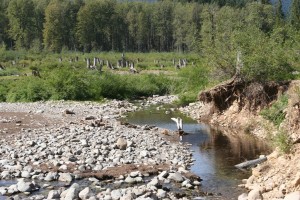Field Trips, What to Look For and Where
“Driftwood” is a misleading term and we should really call it “found” wood. Good wood is everywhere. What we bring home is wood that is down, dead, or dying. Never cut into a living healthy source, no matter how tempting, as there is enough great sculpture wood without being destructive.
Great sources are listed below:
Ocean Beaches: looking near the high tide lines, or better still, at the mouth of rivers, creeks and bays which feed into the sea. In fall water levels are lower and stumps, skags and roots are revealed. Driftwood that has been tumbled by the waves too much could be too sandblasted to have much shape or interest left. Be selective.
Lakes: usually man-made lakes or reservoirs hold great woods that have been left under the lake as the dam is filled. Later these great woods are exposed as the water ebbs, or are washed to shore over time. Look at where the prevailing winds push these potential sculptures to pile up and be exposed. Great lakes like this are: Lake Keechelus, Lake Kachess, Alder Lake, Rattlesnake Lake, Lake Baker and Rimrock lake.
 Rivers, Streams, and Creeks: look were rivers oxbow and change course after a series of heavy rains or floods. Heavy rains wash out clearcuts and broken tree roots. Look at sandbars, and low bank curves. Check your local rivers that give good access, (under road overpasses.)
Rivers, Streams, and Creeks: look were rivers oxbow and change course after a series of heavy rains or floods. Heavy rains wash out clearcuts and broken tree roots. Look at sandbars, and low bank curves. Check your local rivers that give good access, (under road overpasses.)
Woods, Forests, and Open Acreage: look for where old-growth forests are and have been. Large storms and rotten logs often have good hardwood attached that can be easily removed. Look for storms that have burls preserved by pitch resins. Look for interesting shapes in these old clearcuts. Sometimes you must dig under to find that wonderful piece that only has a small tip showing above earth and debris. Sometimes we also saw off those shapes from a larger but inaccessible piece.
Other Places: old orchards, your backyard, in debris beside a road or highway, old woodsheds, along animal paths, old unused roads or paths, hiking trails, garage sales, from friends and on hiking trails. Anywhere trees are or have been.
Wood is all around us and in every country. The best bet for bringing wood home from your travels is to inquire wherever you are and if you can wash it to ensure that no bugs etc. are left, then start working on it before packing for home, it is usually allowed into this country packed in plastic and listed as art.
Remember that remains of cut and harvested trees will hold a wonder of great shapes in the discarded limbs, roots, burls and trunks.
As always be sure there is hardwood in the piece you select. Heavy is a clue. The best design would be the standard art shapes; ovals, the S shape of the Hogarth curve, triangle shapes, and the oval shape of West Coast Indian designs. Also look for the shapes within a rather flat piece. If it appeals to you it’s probably very good. Remember you are the artist.
Always be sure when you go hunting wood to wear good sturdy hiking shoes, take a warm jacket and gloves for handling the wood, possibly tools for digging or sawing off those pieces.
